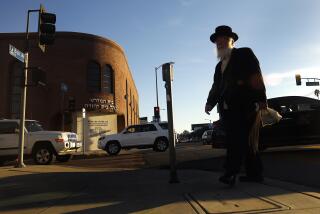Builders Dig Up a Piece of L.A.’s Jewish History
- Share via
The Stars of David cut into the red sandstone blocks are faded and caked with earth, but to local Jewish archivists, they shine as the last remnants of the city’s first synagogue, a structure that was torn down more than 90 years ago.
The two carved stone blocks, which apparently capped pairs of pillars, were dug this week from a pit along Broadway, between 2nd and 3rd streets, where The Times is building a parking garage.
“This is a very exciting find,” said Rabbi Harvey J. Fields of the Wilshire Boulevard Temple, the successor to Temple B’nai B’rith, which was built at 214 or 216 Broadway, then called Fort Street, in 1872-73.
Standing over the stones Wednesday, Fields said their discovery “brings us all close to the realization of how significant the Jewish Community has been in Los Angeles over the course of all these years. . . .
“These stones testify, as all archeological finds do, to the reality of a vibrant life . . . and the beauty of that old synagogue and what it meant in the life of the entire city. So we can’t help but be delighted about it.”
Colin Lindsay, director of administrative services for The Times, said the stones will be turned over either to the Southern California Jewish Historical Society or to the Wilshire Boulevard Temple, which plans a permanent exhibit on the history of Jews in Los Angeles. The temple is celebrating its 125th year.
In addition, Lindsay said, the newspaper will remount a plaque marking the site of the synagogue that was removed from a sidewalk when construction of the parking garage began.
Both Fields and Pauline Hirsh, president of the historical society, said they are certain the stone blocks, which measure perhaps a foot high and more than a yard long, are remnants of the city’s earliest synagogue.
Construction of Temple B’nai B’rith began 10 years after the city’s first Jewish congregation was chartered in 1862. Until the building was completed, the congregation gathered in meeting halls and in the city’s first courthouse, according to an article in Western States Jewish Historical Quarterly.
The new synagogue was designed by one of the leading architects of the day, Ezra F. Kysor, who also drew the plans for the Pico House and the Merced Theater and worked on the design of the Cathedral of St. Vibiana for the Roman Catholic diocese.
An article in the Los Angeles Star of Aug. 19, 1872, described Kysor’s temple design as being “of Gothic formation and adornment.”
The front of the building, the Star announced, will “have two massive buttresses, surmounted by ornamental stone spires handsomely carved. The finial in the center will be surmounted by a five-pointed star set in a circle. . . .”
According to some scholars, the five-pointed star was occasionally used as a Jewish symbol into the late 19th Century.
By the mid-1890s, the congregation of Temple B’nai B’rith had outgrown the synagogue, which had been built to house about 300 people. The building was sold in 1895 to developer Andrew J. Copp, who demolished it the following year to construct a commercial building.
After the original temple was demolished, the B’nai B’rith congregation moved to a new synagogue at Hope and 9th streets. In the late 1920s, it constructed an even larger building on Wilshire Boulevard, and the congregation changed its name.
The sandstone blocks believed to be from the synagogue were spotted by a Times reporter as they lay in the excavated pit and then were removed by the project’s general contractor, Swinerton & Walberg.
Lindsay, the Times official, said the newspaper is not aware that anything else of archeological significance is in the pit.
But, he added, “we’ll naturally do whatever is necessary” to comply with the law.
Parking garages built within city limits are exempt from sections of the California Environmental Quality Act that require an archeological review of certain construction sites before building begins, said Ileana Liel, a senior planner with the city Community Redevelopment Agency.
However, when artifacts are found on any construction site, “then the law would require that construction be halted long enough to monitor the continuing work and just have the heavy equipment operators proceed with a little bit of caution,” Liel said.
More to Read
Sign up for Essential California
The most important California stories and recommendations in your inbox every morning.
You may occasionally receive promotional content from the Los Angeles Times.













